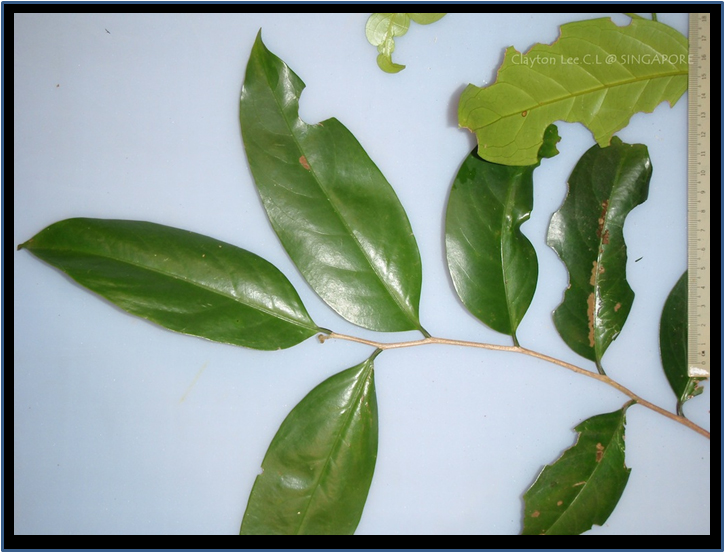Champereia manillana (Blume) Merr., Philipp. J. Sci., C 7: 233 (1912)
Species name meaning 'from Manila' the capital of the Philippines.Synonyms
Cansjera manillana Blume
Cansjera martabanica Wall. [Invalid]
Champereia cumingiana (Baill.) Merr.
Champereia gaudichaudiana (Baill.) Tiegh.
Champereia griffithii Planch. ex Kurz
Champereia lanceolata Merr.
Champereia oblongifolia Merr.
Champereia platyphylla Merr.
Champereya gnetocarpa Kurz
Champereya griffithiana Planch. ex Kurz
Govantesia malulucban Llanos
Nallogia gaudichaudiana Baill.
Opilia cumingiana Baill.
Opilia manillana Baill.
Diagnostics
Usually a shrub or small tree with smooth bark. Stipules absent. Petiole c. 3-5 mm long. Leaves alternate
in one plane, slightly zig-zagging along twig, simple, entire, glabrous, up to 18 by 8 cm, with 5-7
secondary veins. Inflorescences widely branched, but female inflorescences more compact. Bisexual flowers
yellow, female flowers green. Fruit an orange-red drupe, up to 15 mm long.
Description
Small tree, mostly 4-8 m, sometimes up to 20 m, or shrub; stem 5-12(-35) cm diameter; bark smooth, pale.
Slash wood white to cream. Leaves glabrous, ovate, oblong, or lanceolate, (4.5-)6-18(-25) by (1.5-)
2-8(-11) cm; apex slightly acuminate or acute; base shortly attenuate to attenuate, rarely rounded;
midrib above prominulous; nerves 5-7(-8) pairs; midrib and nerves prominent beneath; petiole 3-5(-8)
mm. Panicles solitary or in groups of 2-4; main rachis up to 20 cm long; bracts ovate, acute, 0.5-1
mm long. Flowers: pedicels 2-5 mm, thickened upwards; tepals yellowish green, 1-1.5 mm,
oblong, acute; stamens as long as the tepals, anthers yellow, oval, 0.3 mm long; disk green, annual,
crenulate; ovary green, 0.5 mm long. Female flowers green; pedicels c. 0.5 mm long; tepals c. 0.5 mm,
acute; staminodes minute, 0.2 mm long, scaly; disk lobes smaller than staminodes; ovary cylindric to
ovoid, c. 0.5 mm long; stigma sessile, cushion shaped. Drupe orange-red, (8-)10-12(-15) by 7-9
mm; pedicels c. 1.5-2(-4) mm. [from Flora Malesiana]
Ecology
In open evergreen forest, primary and secondary, and in dry monsoon forest. Sometimes also in
limestone forests. Mostly at low and medium altitudes, from sea level up to 1600 m. Inflorescences
are frequently visited by ants. Fruits eaten by birds.
Uses
Young leaves and young fruits are eaten as vegetables; the fruits are eaten in Thailand, Malaya,
the Kangean Is., Flores, N. Borneo, and the Philippines. Leaves and roots are pounded to make a
poultice for ulcers, and the boiled root is used for rheumatism in Malaya. Mindanao: leaves pounded
and applied for headache and stomachache.
Distribution
From southern China and Taiwan to New Guinea.
Local names
Ambon: sayor garing.
Celebes: borongbenisi, kajuwatu.
China: tai wan shan you.
Flores: sasang, sui.
Malay Peninsula: belkan (sakai), chemperai, chimpri, chipreh, poko kuching-kuching.
Philippines: garimo, liongliong, luingluing, malakabuan, malalukban, malardyap, marisparis; Tag:
ichikamanok; Tagb: panalayapin; Ilk: panalayapon; Sbl: sulanmanok; Sub: talaminuk; Iv: malulukban;
Palawan: duro-manok, laniti; Mindanao: gelenjup, getipun.
Sumatra (Simalur): tutup-mateh.
Talaud Is.: amaloana, aramalu.
